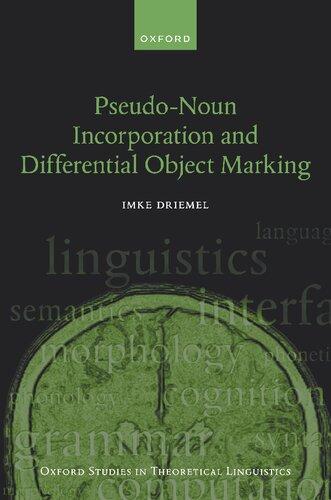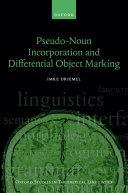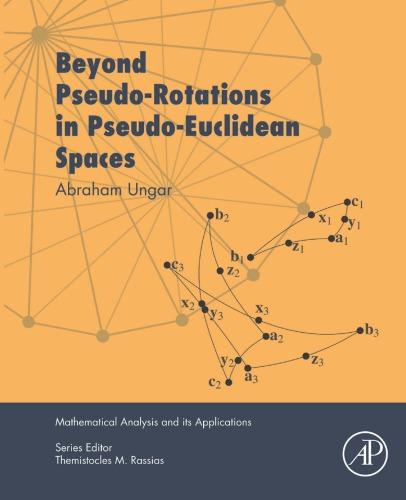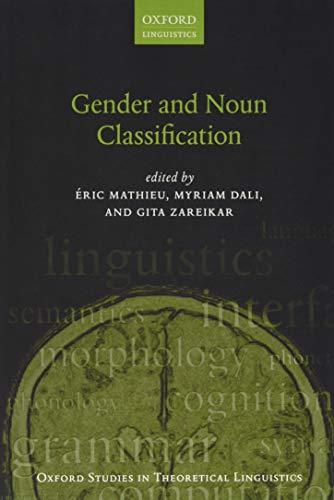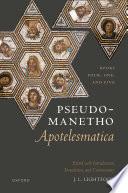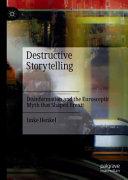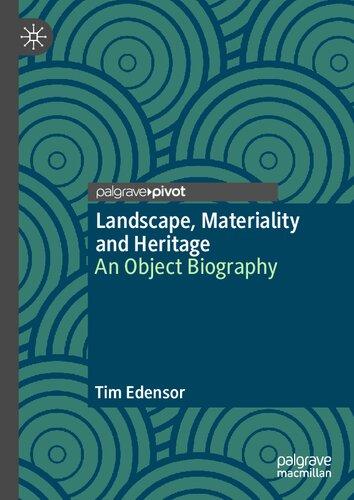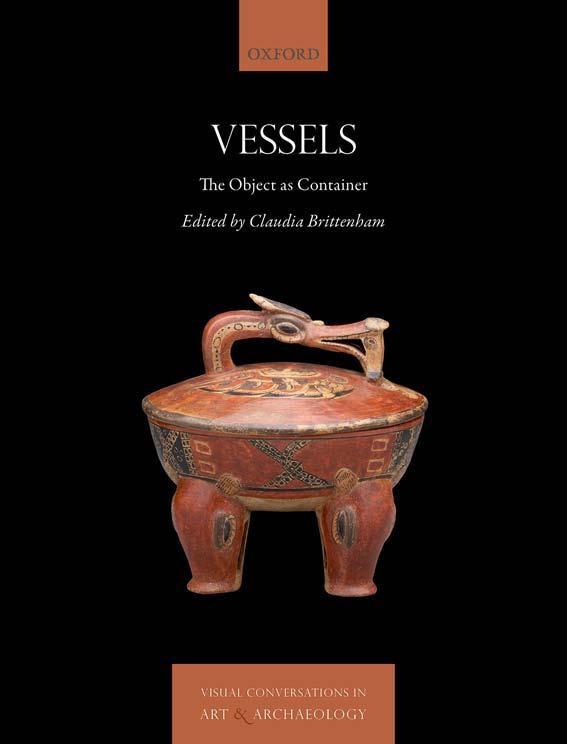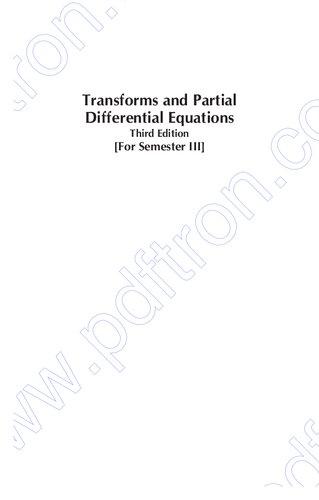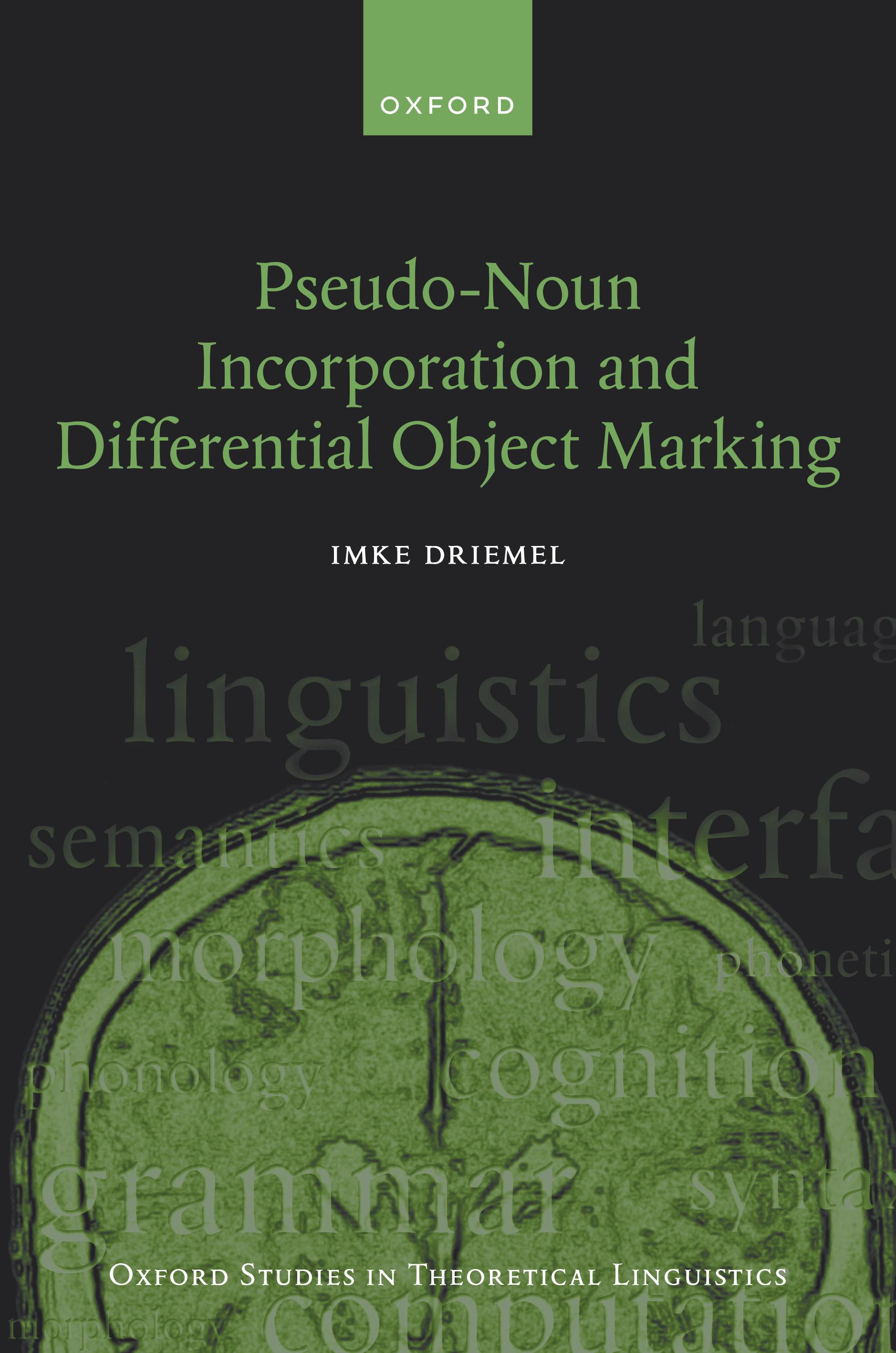Pseudo-Noun Incorporation and Differential Object Marking Imke Driemel Visit to download the full and correct content document: https://ebookmass.com/product/pseudo-noun-incorporation-and-differential-object-ma rking-imke-driemel/
More products digital (pdf, epub, mobi) instant download maybe you interests ...
Pseudo-Noun Incorporation and Differential Object
Marking Imke Driemel
https://ebookmass.com/product/pseudo-noun-incorporation-anddifferential-object-marking-imke-driemel-2/
Beyond pseudo-rotations in pseudo-Euclidean spaces
Ungar
https://ebookmass.com/product/beyond-pseudo-rotations-in-pseudoeuclidean-spaces-ungar/
Gender and Noun Classification Éric Mathieu (Editor)
https://ebookmass.com/product/gender-and-noun-classificationeric-mathieu-editor/
Pseudo-Manetho, Apotelesmatica: Books Four, One, and Five J. L. Lightfoot
https://ebookmass.com/product/pseudo-manetho-apotelesmaticabooks-four-one-and-five-j-l-lightfoot/
Destructive Storytelling: Disinformation and the Eurosceptic Myth that Shaped Brexit Imke Henkel
https://ebookmass.com/product/destructive-storytellingdisinformation-and-the-eurosceptic-myth-that-shaped-brexit-imkehenkel/
Landscape, Materiality and Heritage: An Object Biography Tim Edensor
https://ebookmass.com/product/landscape-materiality-and-heritagean-object-biography-tim-edensor/
Object Oriented Programming_hard_man_v1.pdf Amany Fawzy Elgamal
https://ebookmass.com/product/object-orientedprogramming_hard_man_v1-pdf-amany-fawzy-elgamal/
Vessels: The Object as Container Claudia Brittenham
https://ebookmass.com/product/vessels-the-object-as-containerclaudia-brittenham/
Transforms and Partial Differential Equations T. Veerarajan
https://ebookmass.com/product/transforms-and-partialdifferential-equations-t-veerarajan/
Pseudo-NounIncorporation andDifferentialObjectMarking GeneralEditors
DavidAdgerandHagitBorer,QueenMaryUniversityofLondon
AdvisoryEditors
StephenAnderson,YaleUniversity;DanielBu¨ring,UniversityofVienna;NomiErteschik-Shir, Ben-GurionUniversity;DonkaFarkas,UniversityofCalifornia,SantaCruz;AngelikaKratzer, UniversityofMassachusetts,Amherst;AndrewNevins,UniversityCollegeLondon;Christopher Potts,StanfordUniversity;BarrySchein,UniversityofSouthernCalifornia;PeterSvenonius, UniversityofTromsø;MoiraYip,UniversityCollegeLondon
RECENTTITLES
68 TheStructureofWordsattheInterfaces editedby HeatherNewell,MáireNoonan,GlynePiggott,andLisadeMenaTravis
69 PragmaticAspectsofScalarModifiers TheSemantics-PragmaticsInterface by OsamuSawada
70 EncodingEvents FunctionalStructureandVariation by XuhuiHu
71 GenderandNounClassification editedby ÉricMathieu,MyriamDali,andGitaZareikar
72 TheGrammarofExpressivity by DanielGutzmann
73 TheGrammarofCopulasAcrossLanguage editedby Marı´aJ.Arche,AntonioFábregas,andRafaelMarı´n
74 TheRootsofVerbalMeaning by JohnBeaversandAndrewKoontz-Garboden
75 ContrastandRepresentationsinSyntax editedby BronwynM.BjorkmanandDanielCurrieHall
76 Nominalization
50YearsonfromChomsky’s Remarks editedby ArtemisAlexiadouandHagitBorer
77 MajorityQuantificationandQuantitySuperlatives ACrosslinguisticAnalysisof Most by CarmenDobrovie-SorinandIonGiurgea
78 TheGrammaroftheUtterance HowtoDoThingswithIbero-Romance by AliceCorr
79 TheDerivationalTimingofEllipsis editedby Gu¨lizGu¨nes¸andAnikóLipták
80 NegationandNegativeDependencies by HeddeZeijlstra
81 AnglesofObjectAgreement editedby AndrewNevins,AnitaPeti-Stantic´,MarkdeVos,andJanaWiller-Gold
82 Pseudo-NounIncorporationandDifferentialObjectMarking by ImkeDriemel
Foracompletelistoftitlespublishedandinpreparationfortheseries,seepp.349–351.
Pseudo-Noun Incorporationand DifferentialObject Marking IMKEDRIEMEL GreatClarendonStreet,Oxford,OX26DP, UnitedKingdom
OxfordUniversityPressisadepartmentoftheUniversityofOxford. ItfurtherstheUniversity’sobjectiveofexcellenceinresearch,scholarship, andeducationbypublishingworldwide.Oxfordisaregisteredtrademarkof OxfordUniversityPressintheUKandincertainothercountries ©ImkeDriemel2023
Themoralrightsoftheauthorhavebeenasserted Allrightsreserved.Nopartofthispublicationmaybereproduced,storedin aretrievalsystem,ortransmitted,inanyformorbyanymeans,withoutthe priorpermissioninwritingofOxfordUniversityPress,orasexpresslypermitted bylaw,bylicenceorundertermsagreedwiththeappropriatereprographics rightsorganization.Enquiriesconcerningreproductionoutsidethescopeofthe aboveshouldbesenttotheRightsDepartment,OxfordUniversityPress,atthe addressabove
Youmustnotcirculatethisworkinanyotherform andyoumustimposethissameconditiononanyacquirer
PublishedintheUnitedStatesofAmericabyOxfordUniversityPress 198MadisonAvenue,NewYork,NY10016,UnitedStatesofAmerica
BritishLibraryCataloguinginPublicationData Dataavailable
LibraryofCongressControlNumber:2023930766
ISBN978–0–19–286640–0
DOI:10.1093/oso/9780192866400.001.0001
Printedandboundby CPIGroup(UK)Ltd,Croydon,CR04YY
LinkstothirdpartywebsitesareprovidedbyOxfordingoodfaithand forinformationonly.Oxforddisclaimsanyresponsibilityforthematerials containedinanythirdpartywebsitereferencedinthiswork.
3.Pseudo-incorporationasacategorychangephenomenon
4.Pseudo-incorporationvsdifferentialobjectmarking
5.PNI-propertyI:Restrictiontolowscope
5.4.4Korean
5.4.5German
6.PNI-propertyII:Lackofbindingandcontrol
7.PNI-propertyIII:Movementpatterns
8.Differentialobjectmarking
9.Previousapproaches
Generalpreface Thetheoreticalfocusofthisseriesisontheinterfacesbetweensubcomponents ofthehumangrammaticalsystemandthecloselyrelatedareaoftheinterfaces betweenthedifferentsubdisciplinesoflinguistics.Thenotionof‘interface’has becomecentralingrammaticaltheory(forinstance,inChomsky’sMinimalist Program)andinlinguisticpractice:workontheinterfacesbetweensyntaxand semantics,syntaxandmorphology,phonologyandphonetics,etc.hasledtoa deeperunderstandingofparticularlinguisticphenomenaandofthearchitecture ofthelinguisticcomponentofthemind/brain.
Theseriescoversinterfacesbetweencorecomponentsofgrammar,including syntax/morphology,syntax/semantics,syntax/phonology,syntax/pragmatics, morphology/phonology,phonology/phonetics,phonetics/speechprocessing, semantics/pragmatics,andintonation/discoursestructure,aswellasissuesin thewaythatthesystemsofgrammarinvolvingtheseinterfaceareasareacquired anddeployedinuse(includinglanguageacquisition,languagedysfunction,and languageprocessing).Itdemonstrates,wehope,thatproperunderstandingsof particularlinguisticphenomena,languages,languagegroups,orinter-language variationsallrequirereferencetointerfaces.
Theseriesisopentoworkbylinguistsofalltheoreticalpersuasionsandschools ofthought.Amainrequirementisthatauthorsshouldwritesoastobeunderstoodbycolleaguesinrelatedsubfieldsoflinguisticsandbyscholarsincognate disciplines.
Inrecentyears,investigationsoftherelationshipbetweenaverbanditsobject havebeguntouncoverrichpatternsofcomplexity.Whilesomeobjectsmaintainafairamountofindependencewithrespecttotheselectingverb,othersare morphologicallyandsemanticallybondedtoit.Theclosestsuchbondingisfull nounincorporation,wheretheverbandobjectformasingleword,butthereare looserdependenciesandoneofthese,pseudo-nounincorporation,isthefocus ofthisvolume.Inacareful,cross-linguisticexplorationoftheconstruction,Imke Driemelshowsthatitisdistinctfromfullincorporation,andfromthesuperficiallysimilarDirectObjectMarkingphenomenon,andarguesthatitinvolvesa categorialchangeintheobjectfromanominaltoaverbalcategory.Thiscategorialchangeexplainspatternsofmovement,control,andbindinginthesyntax,but inadditionfeedsintothesystemsthatinterfacewithsyntaxtocapturetheparticularsemanticandmorphologicalpatternsthatcollocatecross-linguisticallywith pseudonounincorporation.Overall,thebooknotonlymakesastrongargument
foramorecomplextypologyofverbobjectdependenciesinthesyntaxthanis usuallyassumed,butalsoshowshowtounderstandthatcomplexityintermsof establishedsyntacticpossibilities.
DavidAdger HagitBorer
Preface Thisbookisarevisedversionofmydissertation,filedinApril2020atLeipzigUniversity.Theworkwasmadepossibletoalargeextentbythepeoplewhoshared theirlanguagewithme.Ithankthespeakersofthelanguagesofthisstudy,who investedtimeandenergyintoansweringthemanyquestionsIhadviaskype,facebook,email,phone,onlinequestionnaires,andinperson—thankyouallsomuch foryourpatience!MyworkalsobenefitedfromconversationsIhadwithanumberoflinguists.Sincethereissignificantoverlapbetweenthesetwosets,Iwill listthemalltogether:ArtemisAlexiadou,SukhbatBaatar,RajeshBhatt,BronwynBjorkman,EmilyClem,RümeysaDijle,ErdenekhishigEldev-Ochir,Daniel Gleim,DolgorGuntsetseg,FabianHeck,JohannesHein,AnkeHimmelreich, AdiyasurenJamiyandagva,GregKobele,HyunjungLee,GereonMu¨ller,Andrew Murphy,JohannesMursell,JeganMurugesan,YiningNie,Bilal&Fatos¸Ozdemir, ManfredSailer,MartinSalzmann,GanzayaSengee,RajamathangiShanmugam, BarbaraStiebels,AravindhanSukumar,SandhyaSundaresan,SergejTatevosov, So¨renTebay,GombosurenTsermed,PhilippWeisser,JoannaZaleska,andMalte Zimmermann.
Ihavepresentedpartsofthisworkatanumberofconferencesanddepartments,whereIreceivedvaluablefeedback.Thanksgototheaudiencesofthe WorkshoponNominalsattheInterfaces(2018),NorthEastLinguisticSociety (2019),JahrestagungderDeutschenGesellschaftfürSprachwissenschaft(2019), GLOWinAsia(2022),aswellasthelinguisticsdepartmentsatLeipzigUniversity, Humboldt-UniversityBerlin,PotsdamUniversity,GoetheUniversityFrankfurt, andUniversityofPennsylvania.
Finally,Iwouldliketothankmyfamilyandfriends,includingJasper,Kati,Jette, Tabea,Theresa,Siri,Jelena,Luise,Anne,Elton,Paula,andMariaforbeingsupportiveandacceptingtheincreasinglyworkaholiclifestyleIhaveadoptedover thepastcoupleofyears,whilewritingthisbook.
Glosses
Listofsymbolsandabbreviations 1,2,3 1st,2nd,3rdperson
ABL ablative
ABS absolutive
ACC accusative
ADD additiveparticle
ADV adverbialsuffix
ADJ adjectivalsuffix
AG agent
AGR agreement
AOR aorist
ATTR attributive
AV agentvoice
CAUS causative
CL classifier
CLIT clitic
CMPD compound
COMP complementizer
CONJ conjunction
COP copula
CV converb
DAT dative
DECL declarative
DEF definite
DEM demonstrative
DET determiner
DOM differentialobjectmarking
DP discourseparticle
DUR durative
EMPH emphatic
ERG ergative
EXIST existential
F feminine
FACT factual
FAM familiar
FOC focus
FUT future
GEN genitive
HAB habitual
HON honorific
INF infinitive
IMP imperative
IMPF/IPFV imperfective
IND indicative
INST instrumental
INT intimate
INTR/INTRANS intransitive
JOIN epentheticvowel
L L-suffix
LNK linkingmorpheme
LOC locative
M masculine
MIR mirative
MOD modality
N neuter
NE nominalparticle
NEG negation
NMLZ nominalizer
NOM nominative
NPREF nominalprefix
NSF nounsuffix
NT neutral
OBJ object
OBL oblique
OV patientvoice
PAT patient
PERF/PFV perfective
PL plural
POSS possessive
PROG progressive
PST past
PRS present
PUNC punctual
REFL reflexive
REL relative
Abbreviations
RES resultative
S S-suffix
SBJ subject
SG singular
STAT stative
T tense
TR/TRANS transitive
TOP topic
UNM unmarkedmorphologicalcase
VOL volitional
BIER binderindexevaluationrule
DM DistributionalMorphology
DOM differentialobjectmarking
EC existentialclosure
EF edgefeature
EI eventidentification
FA functionalapplication
[•F•] structure-buildingfeature
[*F*] agreefeature
[•F•], [*F*], [F] deactivatedfeatures
GQ generalizedquantifier
LF LogicalForm
NI nounincorporation
OT OptimalityTheory
MIR movementinterpretationrule
PA predicateabstraction
PIC PhaseImpenetrabilityCondition
PF PhonologicalForm
PM predicatemodification
PNI pseudo-nounincorporation
QR quantifierraising
SCC StrictCycleCondition
Introduction Pseudo-nounincorporation(PNI)describesaphenomenoninwhichanargumentformsa‘closerthanusual’relationwiththeverb.Thesyntacticconsequence mostoftendiagnosedislossofcasemarking,potentiallyalongwiththelackof otherfunctionalmaterialsuchasnumbermarkingandovertlyexpresseddeterminers.Acorrelatinginterpretiveconsequenceisexpressedbyscopeinertness. BothaspectsareexemplarilyshownforHindiin(1),where(1a)showsthatobjects canbeoptionallymarkedforcaseand(1b)illustratesthecorrelationofcaseloss andaobligatorynarrowscopereading.
(1) Dayal (2011:127,137) Hindi
a.Anu Anu bacca/bacce-ko child/child-ACC sambhaaltii look.after.IMPF hai be.PRS
‘Anulooksafter(oneormore)children/thechild.’
b. ¬∃,*∃¬ Anu Anu bacca child nahiiN not samhaalegii look.after.FUT
‘Anuwillnotlookafterchildren.’
Acommonintuitionmanyanalysesshareisthatpseudo-incorporatedarguments aresomehowreducedintheirsyntacticaswellastheirsemanticcapacity. Togetherwiththeobservationthatpseudo-incorporationseemstoberestricted tooccurwithbarenounsandindefinites,bothcaselossandscopeinertnessare oftentracedbacktothesizeoftheargument.Pseudo-incorporatedarguments areclaimedtobeNPs,denotingproperties ⟨e,t⟩,whichdonotrequirecaseand cannottakescope(Dayal 2011; Massam 2001; vanGeenhoven 1998).Withinthe recentliteratureondifferentialobjectmarking(Aissen 2003; Bossong 1991),this sizerestrictionhasalsobeenarguedtobethecauseforlackofspecificity/animacy interpretations(Kalin2014;Levin2019;López2012;vanUrk2019b),shownhere forSpanishin(2).Oneofthequestionsthisstudywilladdressiswhetherpseudoincorporationanddifferentialobjectmarkingcanbeconsideredastwosidesofthe samecoin.¹
¹ Iwillusetheterm‘differentialobjectmarking’(DOM)inthisbooktosubsumedifferentialobject markinganddifferentialsubjectmarking.
(2) López (2012:16)
a.Marı´a Marı´a busca seeks a DOM una a gestora. manager ‘Mariaislookingfora(certain)manager.’
b.Marı´a Marı´a busca seeks una a gestora. manager ‘Mariaislookingfora(*certain)manager.’
Spanish Thisbookpursuestheideathattheeffectsofpseudo-nounincorporationarenot relatedto size butto category.Pseudo-incorporatedargumentstransformfrom nounsintoverbsduringthecourseofthederivation.Theverbalnatureisresponsibleforthecasedropandtheinabilitytotakewidescope:verbsarecommonly takentobeincapableofinducingscopeshift(Chomsky2001;Harley2004)andare cross-linguisticallyobservedtoconstituteunsuitablehostsforcasemorphology (Moravcsik 2012; Nichols 1986).
Twoadditionaleffectscanbemadetofollowfromtheverbalcharacterof pseudo-incorporatedarguments.AshasbeenobservedforTurkish(Öztürk 2009),Hindi(Bhatt 2007),andSpanish(Leonetti 2004; López 2012),pseudoincorporationisnotlicensedincontextsthatrequiretheargumenttoactasa binderorcontroller.Thesepropertiesareillustratedin(3)forTurkish.
(3) Öztürk (2009:343–344)
a.Ali Ali [c¸erc¸eve-sin-e1∕2] frame-POSS.3SG-DAT resm-ı1/*resim1 picture-ACC/picture koy-du. put-PST ‘Alipicture-putinhisframe.’
b.*Ali-yi
Turkish
Ali-ACC [PRO1 sorgula-mak interrogate-INF ic¸in] for kasıtlıolarak intentionally polis1 police tutukla-dı. arrest-PST
‘Police-arrestinghappenedtoAlitointerrogatehim.’
Theincompatibilityofbindingandcontrolwithpseudo-nounincorporationhas beenattributedtotheneedtoraiseintoorbemergedinadedicatedposition wherecaseisassignedandfromwhichcontrolandbindingtakesplace(Bhatt 2007;López2012;Öztürk2009).Theaccountputforwardinthisbookarguesthat pseudo-incorporatedargumentsareincapableofbindingapronounsincebinding,i.e.theabilitytointroduceanindex,isapropertyessentiallytiedtonominal categories(Baker 2004; Büring 2005).Furthermore,controlrelationscannotbe establishedsincecontrolisdependentonbinding(Chomsky1981;Manzini1983).
Thecategorialapproachpursuedinthisbookmakesanadditionalprediction aboutthemovementbehaviourofpseudo-incorporatedarguments,aproperty thathassofarnotreceivedmuchattention,asitisknowntovaryacrosspseudonounincorporationlanguages.Sincepseudo-incorporatedargumentsturnfrom
nounsintoverbs,theirmovementpatternswillmimickthemovementpatternof VPs,predictingpotentialcross-linguisticvariationacrosslanguageswhichexhibit pseudo-nounincorporation.Theaccountpresentedhereis,thus,wellequippedto explainwhylanguageslikeTamilandSakhadonotpermitmovementofpseudoincorporatedarguments(Baker 2014b),incontrasttoTurkish(Gračanin-Yüksek andİşsever2011;JoandPalaz2019)andHindi(Dayal2011),shownin(4)and(5).
(4) Dayal (2011:137) Hindi Kitaabi book anu Anu zaroor definitely i becegii. sell-FUT ‘Anuwilldefinitelysellbooks.’
(5) JoandPalaz (2019:23) Turkish Kitapi book ben I [Ali-nin Ali-GEN i oku-dug˘-un]-u read-NMLZ-POSS.3SG-ACC du¨s¸u¨n-mu¨-yor-um. think-NEG-PRS-1SG ‘Idon’tthinkthatAlidoesbook-reading.’
TheempiricalbasisofthisbookisformedbyelicitationwithspeakersofTamil, Mongolian,Korean,Turkish,andGerman.Fivediagnosticsareappliedacross elevennountypesineachofthelanguagesunderconsideration,includingbare nouns,numerals,weakandstrongquantifiers,weakandstrongdefinites,demonstratives,propernames,andpronouns.Whatemergesisacoherenteffecton pseudo-incorporatedargumentsthatmapslossofcasemarkingtoobligatory narrowscope,lackofbindingandcontrolrelations,aswellascross-varying restrictionsonmovement.Whilecasepropertiesareregularlytiedtoscopeand mobilityrestrictionsbyDP/NPaccountsofpseudo-incorporation(Dayal 2011; Dobrovie-Sorinetal. 2006; Massam 2001),bindingandcontrolpropertiesare oftenmadeuseofbyraisingapproaches(BhattandAnagnostopoulou 1996; Kelepir 2001; López 2012).Thestudyprovidesaunifyingtheorythatisable tocaptureallpropertieswithasingleassumption:pseudo-incorporationeffects resultfromnounphrasesthataremadeupofanominalandaverbalcategory feature.Implementedinaminimalistderivationalframework(Chomsky 1995, 2000),thenominalfeatureisactiveearlyinthederivationandinthatresponsibleforc-selectionandnominalmodification,whiletheverbalfeatureisactivelate andcruciallyderivestheeffectswehavecometorecognizeaspseudo-nounincorporation.Incontrasttopreviousaccounts,thecurrenttheoryisabletoexplain cross-linguisticvariationconsideringtheextenttowhichpseudo-incorporated nounsarerestrictedintheirmovementcapacitiesbydemonstratingparallelsto VPmovementineachofthelanguagesunderconsideration.
Beyondidentifyingthecorepropertiesofthephenomenon,thebookcontributesanumberofadditionalempiricalobservations,themostimportantbeing thatoptionalcasemarkingisnotnecessarilycausedbypseudo-incorporation. TamilandKoreanprovideevidencethatonlyasubsetofoptionallycase-marked
nountypesshowacorrelationwithscope,binding,control,andmovementconstraints.Thisinsightenforcestheconclusionthatoneandthesamelanguage canmakeuseofbothpseudo-nounincorporationanddifferentialobjectmarking.Moreover,thebroadrangeofnountypesinvestigatedinthisstudyallowsfor importantinsightsintothenominaldomaingenerally,withaparticularfocuson bareargumentlanguages.ThestudyshowsthatMongolianpatternswithTurkish, whichhaspreviouslybeenreportedtoallowoptionalcasemarkingforweakquantifiersandnumeralsbutnotforstrongquantifiers(Enc˛ 1991).Tamil,however, patternswithHindiinthatonlybarenounsarepermittedtoundergopseudonounincorporation.Thecross-linguisticdifferencessupportanalysesthatmake useofthepotentialadjectivalstatusofweakquantifiers,numerals,andindefinite articles(IoninandMatushansky 2006; Milsark 1977; Partee 1988).Furthervaluableinsightsarealsogainedwithrespecttoweakandstrongdefiniteness(Schwarz 2009, 2019),inthatcasemarkingisessentialtofamiliarity-baseddefinites,in contrasttouniqueness-baseddefinites.Byshiftingthescopetomorpho-syntactic properties,thestudyprovidesanewdirectionforaresearchareathathassofar primarilyfocusedontheovertspelloutofdeterminersinbareargumentlanguages (Ahn 2017; Hanink 2018; Jenks 2015, 2018).
Thebookisstructuredasfollows.Chapter 2 justifiesthediagnosticsusedin thisstudyanddiscussestheelicitationmethods,whilealsosummarizingthemain results.InChapter 3,basictheoreticalassumptionsarelaidoutandappliedto themainideaofthisthesis,followedbyabriefdiscussionoftheliteratureon categorychange.Chapter 4 isdedicatedtothemostprominentsyntacticdiagnosticofpseudo-incorporation,thatislossofcasemarkingincorrelationwith semanticeffects.Foreachlanguage,Iwillproposetwowaystomodelcaseloss post-syntactically.Chapter5presentsthescopefactsinmoredetailandtheimplementationofthecategorialapproachintermsofthewidelyobservedlowscope restriction.InChapter 6,Iextendtheproposaltocontrolandbindingfacts,while Chapter 7 willpresentthecross-linguisticvariationinthemovementrestrictions ofpseudo-incorporatedarguments.Thetwolanguagesofthisstudythatdisplay optionalcasemarkingfornountypeswithoutcorrelatingscopalbehaviourwill begivenadetailedlookinChapter 8.Finally,Chapter 9 comparestheresults ofthisstudytoexistingaccountsofpseudo-nounincorporationandDOMand Chapter 10 concludes.
Methodologyandmainresults Thischapterpresentsthemainresultsofthestudy,describesindetailthe elicitationmethodswhichwereused,andjustifiesthediagnosticschosento identifypseudo-nounincorporation.
2.1 Diagnostics Pseudo-nounincorporationisnotoriouslydifficulttodiagnose.Sincethereisno clearovertmorpho-syntacticprocessofformingacomplexnoun–verbpredicate,asisthecasewithnounincorporation,aninterplayoffactorsisoftentaken intoconsiderationwhendiagnosingPNI.Acorrelationwhichhasfrequently beenarguedtobeindicativeofpseudo-nounincorporationisthesimultaneous restrictiontolowscopewiththeabsenceofcasemarking(Baker 2014b; Dayal 2011; KwonandZribi-Hertz 2006; López 2012; Massam 2001; Öztürk 2005).An examplefromHindiwasalreadyprovidedintheintroduction,wherescopalpropertiesweretestedwithrespecttonegation.In(1),weseeanotherexamplefrom Spanish,includingauniversalquantifier.Case-markedobjectsoftenshowflexible scope.Ifcasemarkingisdropped,theexistentialscannottakescopeovernegation(1)oraquantifiedsubject(1).Forsimilarscopeinteractions,see Kwonand Zribi-Hertz(2006:118)forKorean,Kelepir(2001:59)forTurkish,Lyutikovaand Pereltsvaig (2013:129)forTatar, Lidz (2006:14)forKannada,and Testeletsand Arkadiev (2014:7)forAdyghe.
(1) López (2012:13,14) Spanish
a.
Todo every hombre man amo´ loved a DOM una a mujer. woman ‘Everymanlovedawoman.’
,
b.
, *∃∀ Todo every hombre man amo´ loved una a mujer. woman ‘Everymanlovedawoman.’
Whilethelinkbetweenlowscopeandcasedropwillbeusedasaprimarydiagnostictoidentifypseudo-nounincorporationwithinmydataset,wecanfurthermore observethatPNI-edargumentslosetheabilitytoactasbindersorcontrollers. TheseinteractionshavebeennoticedpreviouslyforSpanish(Leonetti2004;López
Pseudo-NounIncorporationandDifferentialObjectMarking.ImkeDriemel,OxfordUniversityPress. ©ImkeDriemel(2023).DOI:10.1093/oso/9780192866400.003.0002
2012),Turkish(Öztürk 2005, 2009),Tatar(LyutikovaandPereltsvaig 2013),and Hindi(Bhatt 2007),see(2)and(3)forillustration.
(2) LyutikovaandPereltsvaig (2013:130) Tatar
a.Marat Marat [balar-lar-nı]1 child-PL-ACC dzˇiba¨r-de send-PST [PRO1 uk-ırga]. study-INF ‘Maratsentchildrentostudy.’
b.*Marat Marat [balar-lar]1 child-PL dzˇiba¨r-de send-PST [PRO1 uk-ırga]. study-INF ‘Maratsentchildrentostudy.’
(3) Öztürk (2009:343) Turkish
a.Ali Ali c¸erc¸eve-sin-e1∕2 frame-POSS.3PS-DAT resm-i1 picture-ACC koy-du. put-PST ‘Aliputthepictureinits/hisframe.’
b.Ali Ali c¸erc¸eve-sin-e*1∕2 frame-POSS.3PS-DAT resim1 picture koy-du. put-PST ‘Alipicture-putinhisframe.’
Thecorrelationbetweenlossofcasemarkingontheonehandandrestrictionto lowscopeaswellaslackofbindingandcontrolontheotherhandprovidesarobust packagediagnostictotrackdownthetypesofargumentswhichcanundergoPNI withinthelanguagesinvestigatedinthisstudy.Furthersupportisprovidedif theclassofnounsalignswiththecross-linguisticrestrictiontobarenounsand indefinites.
AnadditionalpropertyPNI-edargumentsdisplayisapeculiarmovementpattern,onethatisdifferentfromthecase-markedcounterparts.Thisdiagnostic, however,shouldbeconsideredwithcaution.Movementpropertiesarecertainly nothomogeneousacrosslanguages.YetthereisageneraltendencythatPNI-ed argumentsaremorerestrictedintheirmovementcapabilitiesthanproperarguments.ConsiderSpanishagain:whilecaselessargumentscannotbeleft-dislocated (Leonetti2004;Melis1995;Pensado1995),see(4b),theycanstillprecedethesubject,shownin(5).Case-markedarguments,however,canadditionallyundergo left-dislocation.
(4) Leonetti (2004:86) Spanish
a.Ya already conocı´a knew.1SG (a) DOM muchos many estudiantes. students ‘Ialreadyknewmanystudents.’
b.*(A) DOM muchos many estudiantes students ya already los them conocı´a. knew.1SG ‘ManystudentsIalreadyknew.’
(5) Leonetti (2004:97) Spanish Bueno, well este this verano, summer libros, books han have.3PL leı´do. read ‘Well,thissummer,bookstheyhaveread.’
TherearePNIaccountsthatsolelyrelyonanadjacencyrequirementwiththeverb, eitherbecausecaseisnotmarkedmorphologicallyonarguments(Coon 2010; Levin 2015)orbecausecasemarkingisnotinfluencedbyPNI(Frey 2015; Farkas anddeSwart 2003).Iwillaimforatheoryofpseudo-nounincorporationthat canprovideaglobalexplanationfortheabsenceofcase,widescope,binding,and controlwhilealsobeingabletoaccountforcross-linguisticvariationwithrespect tomovementrestrictions.
Inthisstudy,wewilltakeadetailedlookatfivelanguageswhichhavebeen arguedtoshoweffectsofpseudo-nounincorporation:Mongolian(Guntsetseg 2009, 2010, 2016),Tamil(Baker 2014b),Turkish(Enc˛ 1991; Öztürk 2005; vonHeusingerandKornfilt 2005),Korean(Ha.Lee 2006; KwonandZribi-Hertz 2006),andGerman(Frey 2015).Incontrasttopreviouswork,wewilltakea ratherlargenumberofdifferentargumenttypesintoconsiderationandruneachof themthroughthediagnosticsdiscussedinthissection.Twopropertiesarealways paired,forthemostpartwewillinvestigatecaselossonargumentsandeachofits correlationswithscope,binding,control,andmovementcapabilities.Germanis theonlylanguageinthesamplesetwhichdoesnotexhibitcasedrop.Nevertheless, itisarguedtopseudo-incorporatebarenounsaswellasindefinites,dependingon thepositionintheclause.ForGerman,therefore,wewilltakesentenceposition insteadofcasedropasaprimarydiagnosticandpairitwiththeotherthree.Besides barenounsandindefinites,thisstudyconsiderspronouns,propernames,demonstrativeandpossessorphrases,numerals,andquantifiers.Sincethemajorityof thelanguagesinthesetqualifyasbareargumentlanguages,contextsweresetup toprobefordefiniteness,therebypayingattentiontotheweak–strongdistinction (Roberts 2003; Schwarz 2009).
Theupshotofthisprocedureistwo-fold:(i)wecaninspectthesizerestriction proposedforPNIlanguagesacrosslanguagesandthereby—ifuniform—makea valuablecontributiontothesetofPNIdiagnosticsand(ii)wecanteaseapartcase dropasaresultofPNIfromcasedropbeingunrelatedtoPNI.Thelatteroften fallsintothecategoryofdifferentialobjectmarking,aphenomenonwhichsimilarlycentresaroundloss/additionofcasemarkingbutistraditionallylinkedto animacy,specificity,anddefinitenessconstraints(Aissen 2003; Bossong 1991). Chapter 8 providesadetailedcomparisonanddiscussionforKoreanandTamil,
thetwolanguagesformthecoredatasetwhichexhibitDOMaswellasPNIeffects dependingontheargumenttype.
Datafromthefivelanguagesisprimarlybasedonquestionnairesandinterviews runwithnativespeakersoftherespectivelanguages.Twomorelanguages,Spanish andHindi,enterthepictureforcomparison’ssake.Datafromthoselanguagesare takenexclusivelyfromtheliterature.TheresultsfromSpanishandHindiappear intheoverviewtablesbutarevisuallyseparatedfromthecoredatasetandmay containgaps.
2.2 Elicitationmethods,consultants TheMongoliandatawereelicitedwiththehelpofaquestionnaire,puttogether viaskypeinterviewswithDolgorGuntsetseg,anativespeakerofMongoliananda linguistwhohasdoneextensiveworkonthecasesystemofMongolian.Thequestionnairewaspassedontofivenativespeakersviaanonlinestudy.Theconsultants arespeakersofKhalkaMongolian,betweentheagesof28–49,andliveandworkin Ulaanbaatar,thecapitalofMongolia.AllspeakershavelivedandstudiedinGermanyforatleastthreeyearsandarenowemployedinanenvironmentwherethe workplacelanguageisGermanandthereforethecontactlanguagewasGerman. Thesurveyaskedgrammaticalityjudgementsonascalefrom1to5.Scopeand definitenessdatawereelicitedwiththehelpofwrittencontextsaswellasaseries ofpictures.Mongoliansentenceswerepresentedinphonemictranscriptionusing Romanbasicletters,adheringto Janhunen (2012)and Guntsetseg (2016).¹
TheTamilquestionnairewasputtogetherwiththehelpofJeganMurugesan, nativespeakerandlinguist.Threeadditionalnativespeakersservedasconsultants(twolinguistsandonenon-linguist),rangingbetweentheagesof26–40. Elicitationwasconductedthroughone-on-oneinterviews,eitherinpersonorvia skype.TamilsentenceswereprovidedinRomanscript,largelyfollowingLehmann (1993),whichisbasedonthe MadrasUniversityTamilLexicon.Again,scope anddefinitenessdatawereelicitedwiththehelpofwrittencontexts.Thecontact languagewasEnglish.
SincetheworkonKoreanisbasedonacollaborationwithHyunjungLee,linguistandnativespeakerofKorean,thenumberofconsultantsvarytoalarge degree.Themajorityofthedatawasdouble-checkedwithahandfulofKorean speakers(5–12).FortheeffectsofsubjectPNIwithrespecttoscopeanddefiniteness,anonlinestudywasconductedwith54participants,rangingfromages 16–65.Speakerswereaskedtojudgethefelicityofsentencesonascalefrom1to 5,givenspecificcontexts.ThecontactlanguagewasKorean,using Hangul,the ¹ Romanizationisincreasinglyusedinelectroniccommunication,whiletheorthographyofCyrillic KhalkaoftendoesnotcorrespondtothephonemicrealityofspokenKhalka(Janhunen 2012:23).
Koreanalphabet.Datarepresentationinthisbook,however,willmakeuseof thestandardizedYaleromanizationsystem.AsubsetoftheKoreandataisalso discussedin DriemelandLee (2022).
Turkishisalreadyawell-studiedlanguagewhenitcomestocasedropandits semanticeffects(Aydemir 2004; Enc˛ 1991; Kelepir 2001; Kornfilt 1997, 2008; Öztürk2005,2009).Nevertheless,Iconsulted2–3nativespeakers,alllinguists,for scope,control,binding,andmovementeffectsofnon-casemarkedsubjectsand objects.ThecontactlanguagewasEnglish.Finally,Iusedmyownnativespeaker judgementsforGerman,whilealsoconsultingwithahandfulofadditionalnative speakers.
2.3 Mainresults AsummaryofthestudyresultsisshowninTable 2.1.Onequestionthatthisbook attemptstoansweriswhetheroptionalcasemarkingofcertainargumenttypes alwaysboilsdowntothesametrigger.Thereseemstobesignificantoverlapby nowbetweenthephenomenathathavebeenclassifiedasDOMandthecluster ofpropertieswhichareoftenassociatedwithpseudo-nounincorporation.DOMaccountsoftentiecasemarkingtospecificity/definiteness,whereasPNI-accounts
BA =bareargument; IND =indefinite; # =numeral; WQ =weakquantifier; DEMP =demonstrative phrase; WD =weakdefinite; PRO =pronoun; PN =propernoun; POSSP =possessorphrase; SQ =strongquantifier; SD =strongdefinite
Table2.1 Casedropdueto PNI or DOM
trytoaccountforthecorrelationbetweenabsenceofcasemarkingandlowscope. TakeHindiforexample:whereastheDOMstrategyhasbeenpursuedby Butt (1993),BhattandAnagnostopoulou(1996),andAissen(2003),aPNIaccountwas givenby Dayal (2003, 2011).ForSpanish, López (2012)buildsupasystemwhich enableshimtoaccountforboth,thepseudoincorporationofbarepluralsandthe differentialobjectmarkingofindefinites.
WiththediagnosticssetupinSection 2.1 weareabletodrawadistinction betweenDOMandPNI.Onlythelatterwillshowaninteractionbetweencase dropontheonehandandscope,binding,control,andmovementontheother. DiagnosingPNIforonetypeofargument,however,doesnotexcludethepossibilitythatothertypesofargumentscanbeleftcaselessforotherreasons.Itseems reasonabletoassumethatanothertriggerforcaselossisDOM,detectablee.g.via theabsenceofepistemicallyspecificreadings.Hence,thisbookactivelypursues theideathatalanguagecanmakeuseofPNIaswellasDOM,eachcorrelating withdifferentsemanticproperties.² Table 2.1 markseverynountypewith iflack ofcasemarkingisgenerallyanoption,whilecellswhicharemarkedas indicate acorrelationofcasedropwithscope,binding,control,andmovement,inother wordsaPNIpattern.Ifcase-markingisoptional,butonlyinteractswithanimacy or(epistemic)specificity,thecellismarkedwith .Thecurrentstudyrevealsthat MongolianandTurkishdisplayPNIeffectsthroughout,whileKoreanandTamil makeuseofDOMaswellasPNI.
Anoteontheselectionofargumenttypesisinorder.Themajorityofthe PNI/DOMliteraturediscussesbarenouns,definiteandindefinitenounphrases, propernames,andpronouns.Iadditionallyincludenumerals,quantifiers,and demonstrativephrasesinthestudy.ExceptforGerman,alllanguagesfromthecore datasetclassifyasbareargumentlanguages,i.e.theydonothaveanovertdefinite determiner.Contextsthatestablishfamiliaritymentionthereferentinthepreviousdiscourseandtestforstrongdefiniteness.Incontrast,weakdefinitenesscan beestablishedbyanumberoffactorssuchasvisualco-presenceorglobaluniquenessintheculturalcontext(Heim 1982).Thecontrastbetweenstrongandweak definitenessreceivedsomeattentionwithinthelastyears,followingtheworksby Roberts (2003)and Schwarz (2009). Jenks (2015, 2018)concludes,basedonhis workonThaiandMandarinChinese,thatbareargumentlanguagestendtouse barenounsforweakdefinitecontexts,whereasdemonstrativesorovertpronouns takeoverthefunctionofstrongfamiliardefinites.Tomyknowledge,nointeractionhasbeenreportedsofarbetweencasemarkinganddefinitenessinbare argumentlanguages.AsTable2.1shows,stronganaphoriccontextsalwaysrequire casemarkingoftheargument,whileweakdefinitenesscanalsobelicensedwithoutcasemarking,e.g.inKoreanandTamil.WhiletheoptionalcasedropinTamil
² Hence,thisbookalignsinspiritwiththeproposalby López (2012).
isareflectionofaDOMeffect,Koreaninfactpseudo-incorporatesweakdefinites,nextto1/2personpronounsaswellaspropernames,therebyprovidingan exceptionalPNIpattern,withinthesamplesetaswellasinamoregeneralcontext.
Aweak–strongdistinctionhasalsobeenobservedforquantifiers(Kampand Reyle 1993; Milsark 1977; Partee 1988; Zimmermann 2008),wherethestrong typereferstogeneralizedquantifiers,whereastheweaktypeinstantiatespredicate modifierswhichinherittheirquantificationalforcefromacovertc-commanding existentialquantifier.Thisadjectivaltreatmenthasalsofrequentlybeenproposed fornumerals(Link 1987; Krifka 1999; IoninandMatushansky 2006).Twolanguagesoutofthecoredatasetaresensitivetotheweak–strongdistinction.For Turkish,thepossibilitytopseudo-incorporateweakquantifiers,includingnumerals,hasnotgoneunnoticedintheliterature(Enc˛ 1991; Kelepir 2001; Özyıldız 2017).ThecurrentstudyshowsthatMongolianpatternswithTurkishinthis respect.
Finally,itshouldbenotedthatthecategoryindefinite(IND)canconflatewith thecategorynumeral(#),asindefinitedeterminersareoftenhomophonewith numeral one inmanylanguages. Dayal (1999, 2004, 2017)classifiesHindi ek as anumeral,denyingitanyfunctionasanindefinitedeterminer.Itcanbeshown thatTamilandMongolianbehavelikeHindiinthisrespect.AsforKorean, BA and IND collapseintoonecategory,whereasnumeralsclearlyconstitutetheirone category.
Aspertainstothesizerestriction,onlybareargumentscanbeshowntorobustly pseudo-incorporateacrosslanguages.WhereasTurkishandMongolianextendthe PNIclasstoindefinites,numerals,andweakquantifiers,Germanseemstoinclude onlyindefinitesadditionally.Itisreasonabletotiethepossibilityofnumerals andweakquantifiersundergoingPNItotheadjectivalnatureoftheseelements. Languagesthenvarywithrespecttowhethertheydrawacategorialdistinction betweenweakandstrongquantifiers.Korean,perhapsmostsurprisingly,pseudoincorporatesweakdefinites,1/2personpronouns,andpropernames—aselection which,seeminglyrandomatfirstsight,willreceiveauniformtreatmentinChapter 4.TheconclusionsIdrawforHindiandSpanisharepreliminary,basedonthedata availableintheliterature,hencethedashedlinewhichseparatesthetwolanguages fromthecoredataset.
AlthoughtheDOMcellsinTable 2.1 donotshowaparticularsizerestriction, theydorevealgeneralhierarchyeffectswhicharetraditionallyassociatedwith expecteddiscourseprominencebasedongrammaticalfunction(objectsaretypicallylowinanimacy/definiteness,whereassubjectsprovidetheoppositepicture). TheorderofcolumnsinTable 2.1 canbedirectlymappedontoanelaborateversionofAissen’sdefinitenessscale(2003:437),wherestrongdefinitesareranked highestandmostlikelyrequiretobecasemarked,whilebareargumentsconstitute thelowendofthescale.Atthispoint,itshouldbenotedthatthetablesubsumes thePNI/DOMbehaviourofdifferentargumenttypesindependentofgrammatical
function.TurkishandKoreanmakeitpossibletodiagnosesubjectincorporation,revealingthatsubjectsandobjectsshowanidenticalrestrictioninterms ofnountypes.Thisbehaviourservesasacounterargumentagainstfunctional approachestodifferentialargumentmarking(Aissen 2003; Bossong 1991; Croft 1988;Silverstein1976)whichoperateontheassumptionthatonlyargumentswith definiteness/animacypropertiesprototypicalfortheirgrammaticalfunctioncan beleftunmarked,thuspredictingdifferentialsubjectmarkingtomirrortheeffects ofdifferentialobjectmarking.Thisinsight,however,isnotparticularlysurprising, consideringthatsimilarpointshavebeenmadeforTurkish(Kornfilt 2008)and Hindi(deHoopandNarasimhan 2008)inthepast.³
³ ThisviewdoesnotexcludethepossibilitythatPNI/DOMlanguagesshowasymmetrictendencies intermsofhowfrequentcaseisdroppedonprototypicalarguments.Corpusstudiesby Ha.Lee (2006, 2008)showthatwhileKoreandoesnotdifferentiatecategoriallybetweensubjectsandobjects,itdoes sowithrespecttothelikelihoodofcasemarkersbeingpresentandthedefiniteness/animacystatusof theargument.
Pseudo-incorporationasacategory changephenomenon Thischapterpresentsthemainideaofthisbook,itwillbearguedthatpseudoincorporationconstitutesacategorychangephenomenon.Inordertoimplement thisproposal,ImotivatethehypothesisinSection 3.1,layoutmymainassumptionsinSection 3.2,andprovideaconcreteimplementationinSection 3.3. Thefinalsectioncomparesmyproposaltomoretraditionalmixedprojections accounts.
3.1 Sequentialhybrids Pseudo-incorporatedargumentsconstitutehybridcategories:theyarepart nominalpartverbal.Thetwocorepropertiesofpseudo-nounincorporation— lackofcasemarkingandrestrictiontolowscope—aswellastheadditionalthree diagnostics,inabilitytobindorcontrolandrestrictivemovementcapacities,can betracedbacktoitsverbalnature.ThepropertiesPNI-edargumentssharewith properargumentsreflectthenominalstatus,thatistheycheckac-selectional featureoftheverb,theyareassigneda θ-role,andtheycancomewithnumber morphologyaswellasadjectivalmodification.Whereasthenominalpropertiesareuncontroversial,theverbalpropertiesrequirefurtherexplanation.Inthe following,Iwilldiscusseachpropertyseparately.
Oneofthemainreasonswhythesyntacticstatusofheadmovementisso fiercelydebatedintherecentpastcomesfromtheobservationthatverbmovementneverseemstochangescopalrelations.Thishasledmanyscholars,most prominently Chomsky (1995, 2000, 2001)withmanyfollowinghim(Boeckxand Stjepanović 2001; Harley 2004; Merchant 2002; SchoorlemmerandTemmerman 2012; Zwart 2017),toplaceheadmovementingeneralinthepost-syntacticcomponent.Othershavearguedforverbmovementspecificallytotakeplaceinsyntax butwithobligatorysemanticreconstruction(Goldberg 2005; KeineandBhatt 2016; Matushansky 2006).ThescopalpropertiesofPNI-edargumentsthusparallelthoseofverbs,inthattheycannottakescopeoveranotheroperatorinthe sentence.
Oftenimplicitlyassumedamongstmanyscholarsisthatcaseisuniformly expressedonnounsandnotonverbs;see,however, Blake (2004)and
Moravcsik (2012)forexplicitstatementsofsuchkind.Thisopinionfindsempiricalsupportintheworkby Nichols (1986)whoidentifiescaseasthepredominant morphologycategoryfordependentmarkingstrategies,whereasperson,number,andgendermorphologyaremostcommonlyexpressedinhead-marking patterns.Anearlyimplementationofthisdichotomycanbefoundinthe PrinciplesandParameters traditionofGenerativeGrammarwherethelexicalcategories weredistinguishedbytwobinarydistinctivefeatures[±N]and[±V],[ N]categoriesbeingcaseassignersand[+N]categoriestheoneswhichreceivecase (Chomsky 1981; Stowell 1981).Themostrecentinstalmentofcaserelations asexclusivelytiedtonominalsisthetheoryof DependentCase (Baker 2015; Marantz1991;Stiebels2006;Wunderlich1997)wherecasemarkingexpressesthe licensingofonenominalinthelocalpresenceofanothernominal.Thelackof casemarkingonPNI-edargumentsisthusadirectconsequenceoftheirverbal nature.
Inatraditionalframeworksuchas HeimandKratzer (1998)successfulbinding ofa(reflexive)pronounisconditionedbytheintroductionofabinderindex,createdbymovementofanominalphrasewhichisco-indexedwithapronoun.Thus, bindingessentiallyconstitutesarelationbetweennominalsinA-positions(Chomsky 1981). Büring (2005)providesamorerecentaccountofbindingphenomena avoidingthenecessarymovementstepviaaspecialkindofabstractionrule.Nevertheless,thebinderruleisrestrictedtoapplybetweennominals.Finally, Baker (2004)determinesthepropertytobearareferentialindexastheoneidentifying traitthatseparatesnounsfromverbs.Takentogether,theseassumptionsmadein theliteraturecanprovideanexplanationwhyPNI-edargumentsarenotcapable ofactingasbinders,asitseemstobeapropertyessentiallytiedtonominalcategories.Moreover,theinabilityofPNI-edargumentstoenteracontrolrelationis derivedonceitisassumedthatthecontrollerhastoenterabindingrelationwith PRO (Chomsky 1981; Koster 1984; Landau 2015, 2017; Manzini 1983).
WhileIhavesofarpointedoutthreepropertiesthatmakePNI-edarguments behaveunlikenominals(caseloss,lackofbinding,andcontrol)andoneproperty whichpositivelyidentifiestheirverbalcharacter(scope),themovementbehaviour isaswellofthelatterkind.Uponcloserinspection,thecross-linguisticvariation foundwithmovementcapabilitiesofargumentshavingundergonePNIparallel thoseofVPsintherespectivelanguages.
Thenominaltraitsseemtoberelevantearlyinthederivation—c-selectionand θ-roleassignmentaswellasnounphraseinternalmorphologyandmodification areoperationswhichapplybeforeoratthepointtheargumentisfirstmergedwith theverb.Theverbalproperties,however,impactoperationsthataredependent onotherargumentsandfunctionalheadsintheclause.Wewillimplementthis observationbyemployingaderivationalframeworkwhichiscapableofturninga nominalcategoryintoaverbalcategoryinthecourseofthederivation.Hencethe name sequentialhybrid.
3.2 Theoreticalassumptions Theproposalisworkedoutinaminimalistframework,firstintroducedin Chomsky (1995).Minimalismisaderivationalmodelofgrammarinwhichthebasic operations Merge and Agree applyinsequentialorder.Syntacticstructuresare builtbottom-upbysequentialapplicationofMergeandAgreefromasetoflexical items,takenfromthe numeration.Syntacticoperationsaredrivenbytwotypes offeatures:(i)structure-buildingfeaturestriggeringMergeand(ii)probefeatures triggeringAgree.Theyarewrittenas[•F•]and[*F*],respectively.Anemptybox onaprobefeature[*F:□*]signalsthattheprobeislackingavalue.Thenotation istakenfrom HeckandMüller (2007)and Sternefeld (2006).WhileMergeforms complexstructuresbytakingtwolexicalitems(fromtheworkspaceorthenumeration)forminganewitem,Agreecopiesvaluesfromoneelementtoanother,where theformeriscalledthegoal,thelattertheprobe,andthelatterc-commandsthe former(cf. Chomsky 2000, 2001).MovementisdefinedasinternalMerge,where theitemwiththestructure-buildingfeaturecontainstheto-bemoveditem.Finally, [•F•]and[*F*]mustbetargetedanddischargedduringthederivation,thereby restrictingthepossibleoutcomeofsyntacticderivations.Theassumptionsare summarizedin(1)–(4).
(1) FeatureCondition
i.Probes([*F*])participateinAgree.
ii.Structure-buildingfeatures([•F•])participateinMerge.
iii.Afeature[•F•]or[*F*]mustbedischargedbytheendofthederivation. (adaptedfrom HeckandMüller (2007:2)and Müller (2011:123))
(2) Merge
α canbemergedwith β,yielding{α,{α, β}},if α bearsastructure-building feature[•F•]andFisthelabelof β.
(3) Move
MoveisMerge,with β internalto α.
(4) Agree
(HeckandMüller 2007:2)
(HeckandMüller 2007:2)
α canagreewith β withrespecttoafeaturebundle Δ iff(i)and(ii)hold.
i. α bearsaprobefeature[*F*]in Δ andmaytherebyprovidethe α-valuefor amatchinggoalfeature[F]of β in Δ.
ii. α c-commands β (adaptedfrom HeckandMüller 2007:2)
Ifaheadcomeswithmorethanonestructure-buildingorprobefeatureand foreachfeaturethecontexttoapplyismet,the EarlinessPrinciple (Pesetsky 1989)demandsthatthesyntacticoperationstheytriggereitherapplysimultaneouslyorinacertainorder.Recentanalyseshavemadeuseofdifferentorder
relations,derivingfeedingandbleedinginteractionsbetweenMergeandAgree, eitherimplicitly(AnandandNevins 2006; Asarina 2011; Halpert 2012; Kalinand vanUrk 2001)orexplicitlybymakingreferencetoa featurelist or featurestack (Assmannetal. 2015; Georgi 2014; HeckandHimmelreich 2017; Müller 2009, 2010,2011;MurphyandPuškar2018).IwillfollowMüller(2011)andassumethat thefeaturesofoneheadconstitutealistandwillbedischargedoneafteranother, beginningwiththefirstfeatureinthelist.Furthermore,therearenosyntactic operationswhicharenotfeature-triggered.Bothconditionsarestatedin(5).
(5) LastResort
i.Everysyntacticoperationmustdischargeeither[•F•]or[*F*].
ii.Onlyfeaturesonthetopofafeaturelistareaccessible.
(Müller 2011:168)
ThelastsyntacticconditionsIwanttointroduceareconcernedwiththetime window,inwhichasyntacticoperationisallowedtoapply.The StrictCycleCondition(Chomsky1973),see(6),requiresdischargetohappenshortlyafterfeatures enterthederivation,whilethe Phase-ImpenetrabilityCondition (Chomsky 2000) restrictsoperationstoapplybetweenelementswhicharesufficientlyclose,see(7). Itake vPandCPtobephases(Chomsky 2000, 2001).
(6) StrictCycleCondition(SCC)
WithinthecurrentXP α,asyntacticoperationmaynottargetapositionthat isincludedwithinanotherXP β thatisdominatedby α. Müller (2011:120),basedon Chomsky (1973:235)
(7) Phase-ImpenetrabilityCondition(PIC)
Inphase α withheadH,thedomainofHisnotaccessibletooperationsoutsideof α,onlyHanditsedgeareaccessibletosuchoperations.
(Chomsky 2000:108)
Everyprobeandstructure-buildingfeaturecanonlybetargetedonce(Heckand Müller 2007:2).Theygetdischarged,aftertheyhaveundergoneanoperation, inordertomakeroomforthenextfeatureonthestack.Thedischargehasbeen arguedtoresultindeletion,eitherimmediately(Müller 2011:123)oratthe interface(HeckandHimmelreich 2017:66).Thisassumption,however,creates problemsinarealizationalframeworklike DistributedMorphology (DM)(Halle andMarantz 1993, 1994)inwhichmorphologyinsertsexponentsintoabstract morpho-syntacticfeaturestructurespost-syntactically.Deletionofe.g.valuedcase andagreementfeatureswouldtakeawaythefeaturecontextsneededforlateinsertiontoapply,thusresultinginaseverelackofinflectionalmorphology.This issueextendstoLF-relatedfeatures.Ifco-indexationistheresultofanAgreerelationbetweenindexfeatures,asisthecasee.g.in HeckandHimmelreich (2017) betweenafloatingquantifieranda wh-phrase,featuredeletionshouldbeavoided
inordertocreateaninterpretableLF.Whileapre-syntacticapproachtoinflectionalmorphology,asproposedin Müller (2011:168,fn.8),isaviablesolution forPF-relevantfeatures,itisunclearhowitcanhandledeletedfeaturesneededfor LF.Wewillthusassumethatfeaturesarenotdeletedbutbecomeinactiveafterthey havetakenpartinastructure-buildingorAgreerelation;seealso Georgi (2014: 109); Müller (2009:288), Müller (2010:40).¹ Notethat(1iii)doesnotmakereferencetogoalfeatures,theydonothavetobedischargedforthederivationto converge.Theyare,however,neverthelessdischargedaftertheyhavetakenpart inanoperation.
Followingalongtradition,IassumethatstructuralcaseisassignedbythefunctionalheadsTand v (Chomsky 1995, 2000, 2001; Legate 2008; Pesetskyand Torrego 2001; Wurmbrand 2001).Sinceprobesarestandardlycharacterizedas beingunvalued(Chomsky 2001)andDPsarguablyenterthederivationwithan unvaluedcasefeature,eventuallybeingc-commandedbyTand v,caseassignmentdoesnotlenditselftobemodelledbydownwardAgree,asitisdefinedin(4). Hence,caseassignmentisoftenviewedasa‘by-product’of Φ-featureagreement betweenanunvaluedprobefeatureon v/Tandthevalued Φ-counterpartonDP (Chomsky 2001; Danon 2011; GeorgiandSalzmann 2011; HeckandRichards 2010).SinceDPsadditionallycomewithanunvaluedcasefeature,caseisvaluedalongthewaybythealreadyestablishedAgreerelationbetweentheheadand theDP.Thisviewofcaseassignmentcircumventstheproblemofunvaluedcase featuresbeingc-commandedbyvaluedprobes.AwaytoimplementcaseassignmentdirectlyviaAgreeisbysimplygivinguptheideathatprobehoodisdirectly linkedtounvaluedfeatures(Assmannetal. 2014, 2015; HeckandHimmelreich 2017; HeckandMüller 2007).Theunvaluedcasefeatureonanargumentcanthus serveasagoal,while v/Tactsasaprobewithavaluedcasefeature,necessitatinganadditionaldiacritic(*F*)tomarkitasaprobe.Yetanotherwaytoavoid thereversedirectionofprobingistogiveuponthenotionof valuation altogether andinsteadassumea checking accountofcaseassignment,inwhichbothprobe andgoalenterthederivationwithvaluedcasefeaturesbutAgreerequires matching offeatures(Müller 2009, 2011).Iadoptthesecondoption,adirectvaluation approach,althoughnothinginthepresentaccounthingesonthatdecision.
Asamplederivationfor(8)isgivenin(9)–(14),focusingonselectionandcase assignmentandignoring Φ-featureagreementforthesakeofsimplicity.
(8)EveryboykissedJohn.
Asafirststep,VundergoesMergewiththedirectobject(9),tocheckits[•D•] feature,resultingindeactivationofboththestructure-buildingfeature[•D•]and thegoalfeature[D]ontheobject(deactivated[•N•]istheresultofanearlierMerge
¹ Deactivatedfeaturesaremarkedingrey: [•F•], [*F*], [F].
